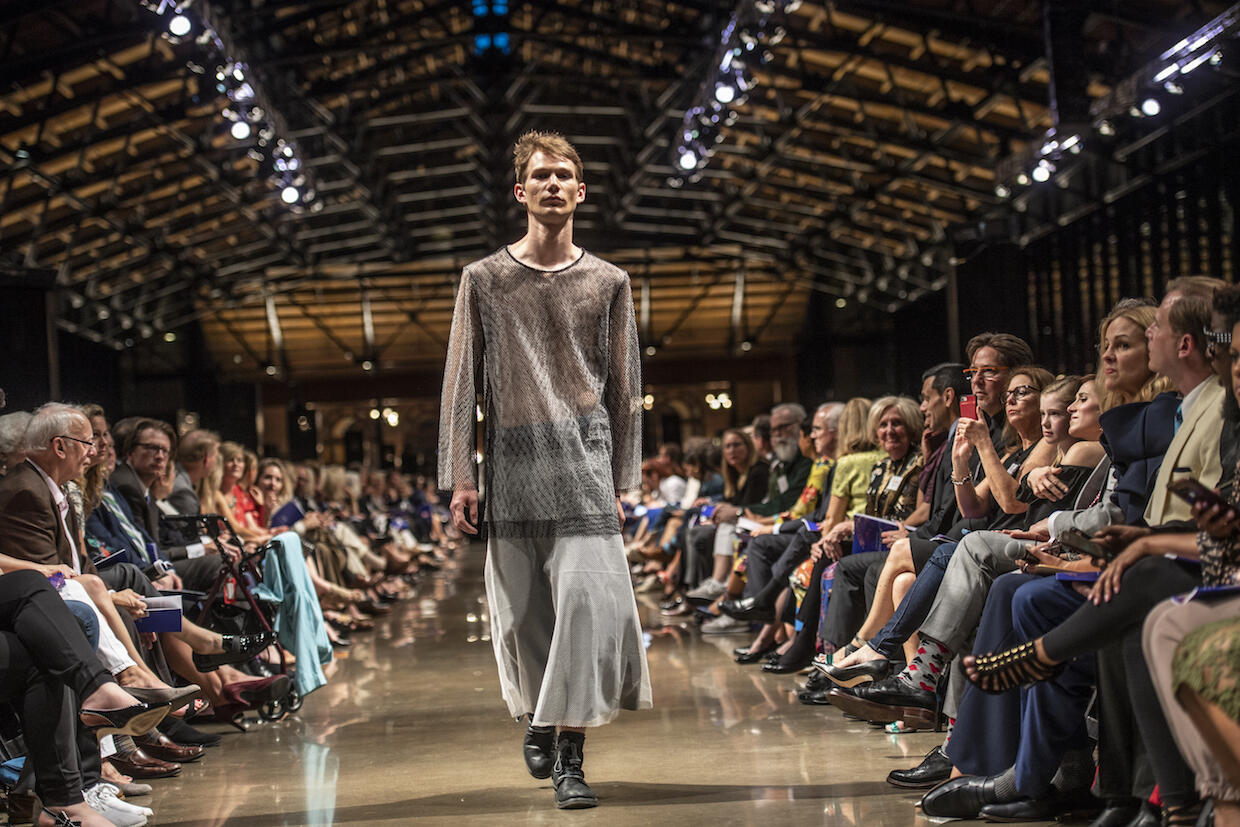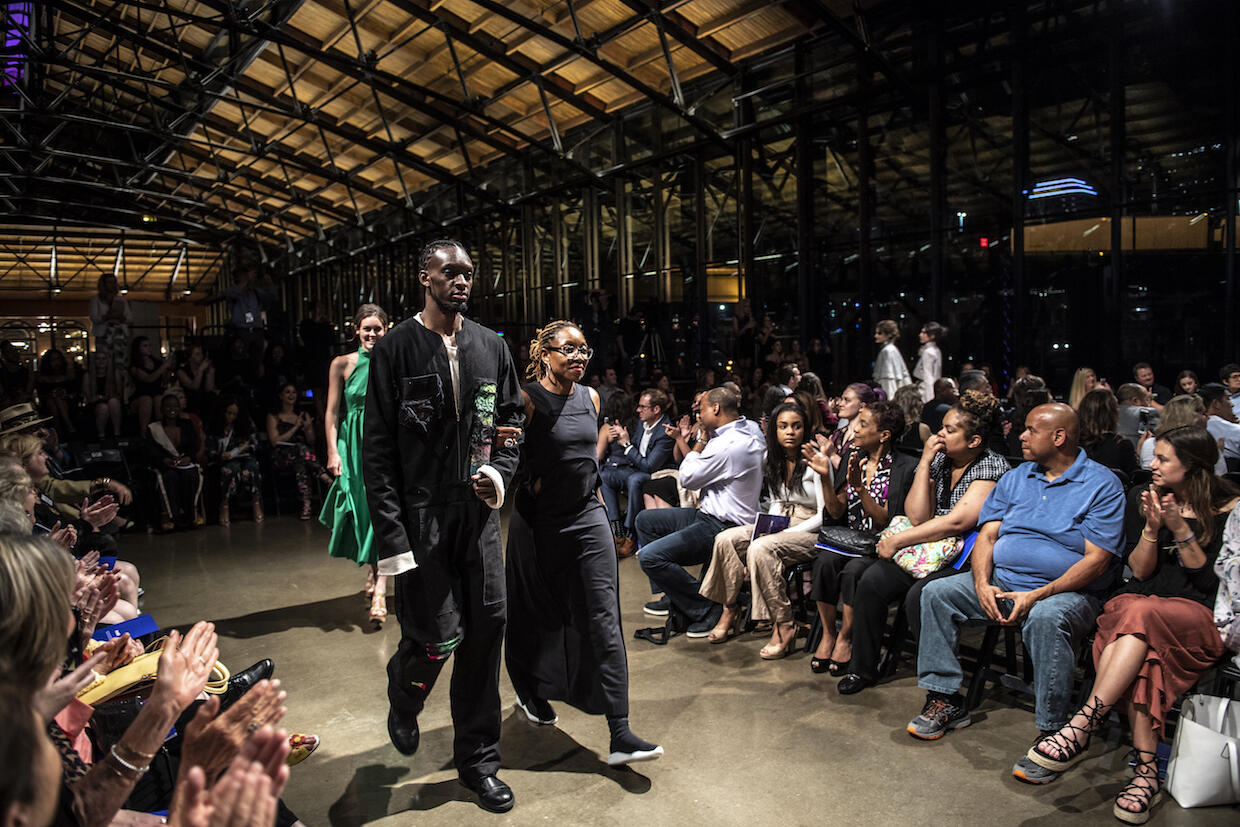May 22, 2018
How fashion students’ designs gained momentum as senior year progressed
Share this story

From the bridges of New York City to the streets of Cincinnati, inspiration for the collections in this year’s VCU School of the Arts annual Juried Fashion Show, “Momentum,” came from myriad sources.
This annual show highlights the work of VCUarts fashion design students, as well as the production talents of fashion merchandising students. The May 10 show was organized by 11 junior and senior merchandising students enrolled in the department’s Advanced Show Production class, in collaboration with design students, fashion faculty and sponsors. Students produced all aspects of this year’s gala — held for the first time at Main Street Station’s new train shed venue — from model selection and training to backstage operations.

“We must help our students launch their careers in a fast-changing environment,” said Patricia Brown, chair of Fashion Design and Merchandising. “The runway event is the result of a journey of exploration and discovery and launches our graduating designers and merchandisers into the new fashion space.”
VCU News met with six fashion design students — now newly graduated — to discuss how their designs came to life:

Conner Karlen interned in New York City last summer and became interested in architecture, especially the negative space within bridges.
“I did quilting, so [in] the negative space in between the quilting I put mesh in,” he said. “I liked that on the wires on the bridges.”
One garment in his collection was a bomber jacket that combined black-and-white mesh to blur the viewer’s vision. He didn’t know how to work with mesh and had to learn to cut the lattice-pattern fabric slowly to make sure the edges stayed even.

A reservist in the military, Phyllis Sackey-Solomon designed a collection of military flight suits with a feminine touch.
“Regular flight suits are tailored for a masculine body so my collection has deep V-necks, and really deep pockets — because women's wear really gets shallow pockets — so I focused on that,” she said.
She also incorporated African prints in the collection. Not wanting to buy a generic pattern, she used a laser cutter to etch out her own custom design.
“Fashion means that you can go from a very up high look,” she said. “So you can be casual, you can be super dressy. Whether it's throwing on sneakers or throwing on heels, I think [with] fashion you should be able to play it up.”

Inspired by the environment, Kathy Schraf built her collection on upcycled materials.
“Clothes that I got from a thrift store, I tore them apart and made new clothes with [the material],” she said. “So my inspiration [was] the environmental impact that my collection is going to make. That was my first step: How am I going to make it sustainable?”
Schraf added new life to the old clothing with fabric marbling, an ancient Japanese technique in which color is floated on water in a shallow pan and then transferred to the fabric, creating patterns similar to marble.
“I think fashion can be an important factor to stop the environmental impact humans are having,” she said. “Right now it's one of the most harmful industries to our planet and I think in the future, fashion should be doing all it can to change that.”

Anna Carlson drew inspiration from the streets of Cincinnati where her mother grew up.
“My grandfather … was an advertising exec for a news company in downtown Cincinnati and the whole city is art deco, so I kind of got inspired by him and liked the graphic idea of advertising in newspapers, but also the graphic of art deco mosaics and the bold contrast of color and very geometric patterns.”
She described her collection as art deco-meets-mod, with simple shapes and silhouettes but with seaming to create a geometric shape. One piece has darts that radiate out from the neck, creating an art deco motif, while a pair of pants has eliminated the side seams and wraps around the body.
“They'll fit anyone,” she said, “but they just cinch in and look really cute when they're on. For this overall collection, I was trying to make pieces that are really easy to wear but very fashionable. … I did that through the seaming and through the creation of motifs, but keeping it very simple in terms of a single color so you can throw it on and not have to really think about matching it with something.”
Carlson laser cut all of her sequins out of acrylic and then hand applied them to the fabric. She heat-transferred a sheet of plastic to organza to create a sheen plastic effect, which changed the feel of the organza.
“It’s like trial and error,” she said. “I mean it's really just making samples and seeing how they work and then making adjustments.”

Ever since she was a child, Nica Mendoza loved making or creating her own outfits from whatever she could find around the house.
“[Fashion] has always been in my blood,” she said. “My inspiration for my collection actually comes from popular culture — a lot of video games, a lot of post-apocalyptic scenarios like ‘The Walking Dead.’ Like some of the silhouettes from those type of shows or different video games that are out, as well as decomposition of buildings and graffiti work on the building. I just wanted to merge those things and see what I could do to manipulate different textiles.”
In her garments, Mendoza hand dyed and hand printed different fabrics.
“I learned some new low-tech printing techniques while doing this collection,” she said. “Taking different dyes and just using different formulas and coming up with different consistencies with the dye and hand applying them or using other objects to apply. I thought that was pretty fun and neat to do because it's something I hadn't really explored much.
“I will never look at garments the same again after going through a fashion design program. Actually not just garments, [but] anything made in general, especially when you learn … the technical aspects of things. Just look at things now and [think] somebody sits and designs every little detail to things so they can go to a factory or wherever and be made to specification.”

Fashion has always been something that Maya Cross has adored since the fourth or fifth grade when she found out she could put art and clothes together.
“I made this terrible dress,” she said of her first creation. “It was just an A-line dress with my aunt and it was terrible, but it was so good because it was the first thing that I had made. I was really proud of it.”
For her pieces in the fashion show, she was inspired by her grandfather's home in Chicago. He did a little bit of everything, from interior design to fashion, Cross said.
“He made this room he called the Arizona room and it was always my favorite room in his house,” Cross said. “Everything in it was handcrafted and painted — everything he did. So I just took a little bit of inspiration from the American Southwest. … My designs are very innovative and they are very different. They're not for the girl that's shy to stand out, and I think that's really, really good in the fashion industry and also life in general: Don't be afraid to show who you are and be different.”
Subscribe to VCU News
Subscribe to VCU News at newsletter.vcu.edu and receive a selection of stories, videos, photos, news clips and event listings in your inbox.










